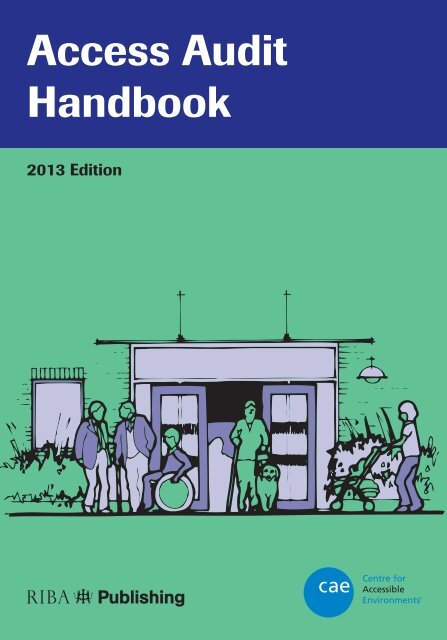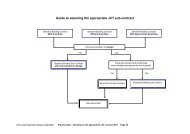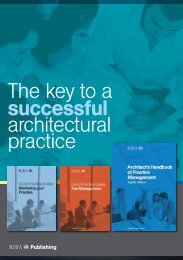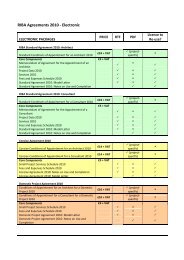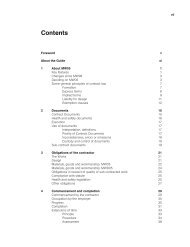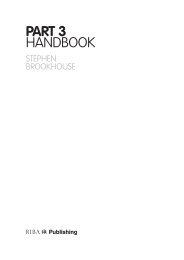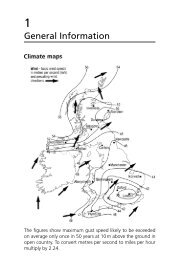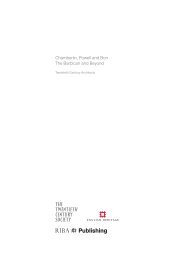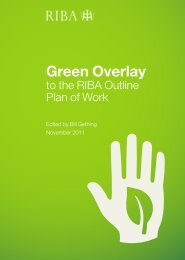Access Audit Handbook - RIBA Bookshops
Access Audit Handbook - RIBA Bookshops
Access Audit Handbook - RIBA Bookshops
- No tags were found...
You also want an ePaper? Increase the reach of your titles
YUMPU automatically turns print PDFs into web optimized ePapers that Google loves.
<strong>Access</strong> <strong>Audit</strong><strong>Handbook</strong>2013 Edition
<strong>Access</strong> <strong>Audit</strong><strong>Handbook</strong>Alison GrantCentre for <strong>Access</strong>ible Environments1
© Centre for <strong>Access</strong>ible Environments and <strong>RIBA</strong> Publishing, 2013Published by <strong>RIBA</strong> Publishing, 15 Bonhill Street, London EC2P 2EAISBN 978 1 85946 492 2Stock code 79860The right of Alison Grant to be identified as the Author of this Work has been asserted inaccordance with the Copyright, Design and Patents Act 1988.Original front and back cover illustrations drawn by Alison Grant.All rights reserved. No part of this publication may be reproduced, stored in a retrievalsystem, or transmitted, in any form or by any means, electronic, mechanical, photocopying,recording or otherwise, without prior permission of the copyright owner.British Library Cataloguing in Publications DataA catalogue record for this book is available from the British Library.CAE Publications Project Manager and Editor: Geraldine McNamaraCommissioning Editors: Lucy Harbor and Steven CrossProject Editor: Neil O’ReganDesigned and typeset by: Steve Paveley DesignPrinted and bound by: W.G. Baird, AntrimWhile every effort has been made to check the accuracy and quality of the information givenin this publication, neither the Author nor the Publisher accept any responsibility for thesubsequent use of this information, for any errors or omissions that it may contain, or forany misunderstandings arising from it.<strong>RIBA</strong> Publishing is part of <strong>RIBA</strong> Enterprises Ltd.www.ribaenterprises.com2
ContentsContents1.0 Introduction 5Who should use this handbook? 52.0 <strong>Access</strong> audits 62.1 What is an access audit? 62.2 <strong>Access</strong> audits and the Equality Act 2010 72.3 <strong>Access</strong> audits, access statements and the planning 9and building regulations process2.4 What follows an access audit? 102.5 Commissioning an access audit 113.0 <strong>Audit</strong> methodology 133.1 The site survey 133.2 What do you audit? 143.3 Survey equipment 313.4 Observational assessment 333.5 Data recording 373.6 User participation 383.7 Building management 424.0 Report writing 444.1 A communication tool 444.2 Report formats 474.3 Establishing the legislative context 484.4 Criteria for assessment and design guidance 494.5 Making recommendations 534.6 Priorities and categories 554.7 Cost banding 585.0 <strong>Access</strong> audit extracts 60Extract one – Penguin Beach, London Zoo 61Extract two – Almeida Theatre 66Extract three – St John’s Church, Notting Hill 746.0 Case study – Hebden Bridge Town Hall 847.0 <strong>Access</strong> audit checklists 92Appendices 165Organisations 165Publications 167Index 1723
AcknowledgmentsWe wish to acknowledge the help provided by the following organisations in the preparationof this publication:Almeida TheatreArts <strong>Access</strong> AustraliaChanging Places ConsortiumEden ProjectEurotunnelHebden Bridge Town HallSt John’s Notting HillZSL London ZooPhotographs of Hebden Bridge Town Hall supplied courtesy of Jade Smith4
Introduction1.0 IntroductionWho should use this handbook?This handbook is aimed at experienced access professionals, as well as people who are newto access auditing, who may include:• business owners, managers andother service providers• architects• surveyors• interior designers• building and facilities managers• access groups• access officers• building control officers• equality and diversity officers• customer services managers• human resources staff• health and safety officers• occupational therapistsThe handbook explains what an access audit is and its purpose within the process ofidentifying, planning and implementing improvements to make buildings, environments andservices more inclusive.Undertaking an access audit is considered good practice and is an effective way of exploringpotential barriers to access. The handbook also sets out the legislative context for undertakingaccess audits in acknowledgement that many audits are commissioned in response to dutiesunder equality legislation. The handbook provides detailed guidance on how to undertake anaudit survey and explains what an audit should include and how to go about it in practice.Communicating the results of an access audit effectively is critically important so that clientsare able to understand and consider recommendations in the context of their business ororganisation. The section covering report writing describes the different ways of recording thefindings of an audit and setting out recommendations for implementing change. For clients whoare commissioning an access audit, the handbook includes useful information on issues thatshould be considered before appointing an access auditor or consultant. The importance of userparticipation and consultation is also set out in recognition of the valuable contribution that staff,volunteers, regular visitors, access groups and relevant professionals can make to the accessaudit process.<strong>Access</strong> auditing is a complex activity and people new to the field are encouraged to undergotraining. It can also be beneficial to gain experience of access auditing by working alongsidean experienced access professional.This handbook is intended to be used together with the CAE / <strong>RIBA</strong> Publishing guideDesigning for <strong>Access</strong>ibility (2012 edition). The checklists in this handbook, which providea useful starting point when commencing an audit, correlate closely with the technicalguidance in Designing for <strong>Access</strong>ibility.5
<strong>Access</strong> <strong>Audit</strong> <strong>Handbook</strong>2.0 <strong>Access</strong> audits2.1 What is an access audit?An access audit is a means of assessing features of an environment (building or externalarea) and services in terms of accessibility. Although now well established, access auditsremain an evolving concept and may mean different things to different people. An accessaudit is a measure of how well the environment and method of service delivery meet theneeds of existing and potential users, whether they be staff, visitors, volunteers, pupils,patients, students or others. It is also a process through which potential barriers to accessmay be identified and recorded alongside suggested improvements in a way that enablespeople responsible for a site, building or service to move on to the next step of planning andimplementing change.<strong>Access</strong> audits have evolved over time – they have been undertaken by specialist consultants,architects, occupational therapists and disabled people for many years as a means ofassessing an existing environment and services, and identifying potential improvements tofacilitate access.An assessment of access provision in either existing buildings or proposed developmentshas been a core requirement of some funding bodies for many years, notably the City BridgeTrust (in London), Arts Council of England and other National Lottery distributors.The increase in prevalence of access audits over the last decade was undoubtedly promptedby the duties placed on employers and service providers under the Disability DiscriminationActs 1995 and 2005. Under these Acts, employers and service providers were required tomake reasonable adjustments to policies, practices, procedures and premises where anyof these created a potential barrier to disabled people. The role of an access audit becamefirmly established as a means of identifying reasonable adjustments and a starting point inthe process of implementing change. In England, Scotland and Wales, the Equality Act 2010has replaced the Disability Discrimination Acts and other single-issue legislation with asingle Act, but continues to identify access audits as a key measure of identifying reasonableadjustments – this is discussed in more detail below.Carrying out an access audit comprises a series of tasks, typically starting with briefing / datagathering, followed by a detailed site survey, consultation with building users and thepreparation of a written report to record and communicate the outcome of the audit.Guidelines for commissioned audits are set out at the end of this chapter under the headingCommissioning an access audit. The more practical elements of the audit, such as the sitesurvey and consultation with building users, are discussed in chapter 3 <strong>Audit</strong> methodologyand guidelines for recording the audit data and recommendations in chapter 4 Report writing.The basic principle of an access audit is comprehensively to assess the accessibility of anenvironment, its facilities and any services delivered from it. To do this, the auditor must take6
2.0 <strong>Access</strong> <strong>Audit</strong>sinto account all existing and prospective building users and consider any potential barriersthat may render part of a building or a service inaccessible or difficult to use by anyparticular group of users. Depending on the environment, facility or service being audited,consideration should be given to people who are service users, employees, volunteers andstudents or pupils in an education environment.The Centre for <strong>Access</strong>ible Environments defines an access audit as a means of:• examining the accessibility of services and facilities• identifying where physical barriers may compromise access to services by assessing thefeature against predetermined criteria• measuring the ‘usability’ of facilities within a building and the services being delivered in it2.2 <strong>Access</strong> audits and the Equality Act 2010The Equality Act 2010 (the Act) replaced existing anti-discrimination legislation with a singleAct and applies in England, Scotland and Wales. The Act unified legislation that previouslycovered different aspects of discrimination separately. Most of the Act came into force inOctober 2010; other aspects, including the public sector Equality Duty, came into force inApril 2011. Previous legislation, including the Disability Discrimination Acts 1995 and 2005,are now repealed. (In Northern Ireland, the Disability Discrimination Acts 1995 and 2005 andother single-issue equality legislation still apply.)The Act protects people from discrimination on a range of grounds, which it refers to as‘protected characteristics’. These are:• age• disability• gender reassignment• marriage and civil partnership• pregnancy and maternity• race• religion or belief• sex and sexual orientationA cornerstone of the Act is the duty to make reasonable adjustments to ensure that disabledpeople are not substantially disadvantaged when compared with non-disabled people. Theduty to make reasonable adjustments relates only to disabled people – it does not relate topeople on the basis of any of the other protected characteristics.The link between access audits and the duty to make reasonable adjustments was clearlyestablished in the Codes of Practice to the Disability Discrimination Act 1995. Thesespecifically referred to an access audit as a means of identifying improvements from whichan access plan or strategy could be developed.7
2.0 <strong>Access</strong> <strong>Audit</strong>s<strong>Access</strong> audits are not only relevant to service providers. Employers have a duty under Part 5of the Act to make reasonable adjustments to ensure that disabled people can access andprogress in employment. The duty to make reasonable adjustments applies to all employers,whether they are small or large organisations, although what is considered reasonable fordifferent employers to undertake will vary according to the employer’s circumstances.Under Part 6 of the Act, further and higher education providers have a duty to makereasonable adjustments to ensure that disabled students are able to access and participatein all aspects of learning and to enjoy the other benefits, facilities and services associatedwith their education. In schools, the Act introduces a duty to make reasonable adjustmentsin relation to the provision of auxiliary aids and services. The duty to make reasonableadjustments to physical features of school premises is already covered by the accessibilityplanning duties.The public sector Equality Duty, which has been implemented to ensure that public bodiesplay their part in making society fairer, came into force in April 2011 and replaced theprevious separate disability, gender and race equality duties. The aims of the duty arethree-fold:• to eliminate unlawful discrimination, victimisation and harassment• to promote equality of opportunity for all• to foster good relations, promote understanding and challenge prejudiceUnderpinning the Equality Duty is the expectation that public bodies actively engage withpeople with different protected characteristics as a means of identifying appropriatesolutions to potential barriers, to prioritise aims and help in the development of effectivepolicies. Engagement sits comfortably alongside the access audit process and provides aninvaluable contribution to ongoing decision-making and the formulation of an access planor strategy for implementing change.2.3 <strong>Access</strong> audits, access strategy and the planning and buildingregulations processThe preparation and submission of an access strategy has been required for some years nowto accompany applications for planning and listed building consent and for approval underthe building regulations. (Some applications relating to existing dwellings are exempt fromthis requirement, as are planning applications that relate to works other than buildings.)At the planning application stage, the access strategy is often incorporated into thebroader document referred to as a design and access strategy. The design and accessstrategy describes how a design has evolved and how provisions for access have beenincorporated.9
<strong>Access</strong> <strong>Audit</strong> <strong>Handbook</strong>In many cases, such as where a proposed development includes changes to an existingenvironment, the access strategy naturally evolves from an access audit and explains howexisting barriers are to be overcome or improved.Under the building regulations, an access strategy is required to accompany applicationsfor non-domestic buildings and should describe how access has been incorporated into thedesign. An access strategy submitted at this stage should be a development of the accessstrategy submitted at the planning stage – it is not a separate document, but an evolutionof the same document which is updated as the design progresses. Where features of theproposed building work deviate from guidance in Approved Document M: <strong>Access</strong> to and useof buildings (2004 edition incorporating 2010 and 2013 amendments) the access strategyshould explain why this is the case and how the adopted design satisfies the regulations.At both the planning and building regulations stages, the access strategy should record theoutcomes of consultation exercises with disabled people, local interest groups andspecialist advisors.The National Planning Policy Framework, which was published in March 2012, sets out thegovernment’s reforms to the planning system in England, which are focused on simplifyingthe planning system, making it more accessible, protecting the environment and promotingsustainable growth. Key to the Framework is engagement with local communities and thedevelopment of neighbourhoods and communities. Engagement at all stages of the planningand design process is essential to meet local need and to ensure environments are inclusive.2.4 What follows an access audit?An access audit is the first stage in the process of identifying, planning and implementingchange. An access audit should not be considered as achieving an end in itself, but rather ameans by which people responsible for a physical environment or service can move forwardtowards the preparation of an access plan or strategy and the effective implementation ofadjustments, whether they be operational, management or physical changes.The Code of Practice to Part 3 and Part 7 acknowledges that conducting an access audit ispart of a process and that acting on the outcomes of an audit is key to meeting obligationsunder the Act. Importantly, the Code highlights that conducting an access audit and actingon the outcomes may mitigate the likelihood of claims of alleged discrimination.10
2.0 <strong>Access</strong> <strong>Audit</strong>sThere may be instances where subsequent audits are undertaken of the same premises orservice, for example as a part of a continual cycle of review. An access audit is, by nature, arecord of a building and its functions at one particular moment in time – it records thefeatures and arrangements in place when the audit was undertaken. Following the audit,adjustments should be put in place which result in the removal of barriers and animprovement in the way services are delivered. Implementation of changes will clearly markan improvement in accessibility, but should not be regarded as a fait accompli. The Codeof Practice encourages service providers to regularly review the way in which services areprovided, not simply to consider the issue as a one-off exercise. One way of achieving thisis to undertake periodic audits or to review and update an audit previously undertaken.Undertaking a subsequent audit may be appropriate if the building has been refurbishedor if the nature of the client or service provider’s business has changed. Undertaking asubsequent audit may provide the best opportunity to update recommendations in line withdeveloping legislation and best practice design guidance.The case study in chapter 6 illustrates how a service provider has moved forwards froman initial access audit to plan and implement improvements to transform an inaccessiblehistoric building into a thriving multi-use development.2.5 Commissioning an access auditWhere an access audit is to be undertaken by a person (or persons) outside the clientorganisation, the fees, timescale, terms of engagement and scope of works should beclarified at an early stage and clearly set out to record the agreement between the clientand auditor. The items in the inset box on page 12 provide a checklist for both clients andauditors.11
<strong>Access</strong> <strong>Audit</strong> <strong>Handbook</strong>Commissioning an access audit – issues for the client and auditor to consider:Terms and conditions of appointment – For the benefit and protection of both clientand auditor, the terms and conditions of appointment should be confirmed before thecommencement of any commission. Terms and conditions should include the client’s andauditor’s duties under the agreement, payment mechanisms, levels of professionalindemnity and other insurance cover, an understanding relating to confidentiality andcopyright, any particular requirements relating to communication methods and amechanism by which the agreement can be terminated and suspended. The <strong>Access</strong>Consultancy Services Schedule Supplement to the <strong>RIBA</strong> Forms of Appointment is asuitable model to use. The National Register of <strong>Access</strong> Consultants (NRAC) has produceda model Terms and conditions for the engagement of an access consultant or auditor andan Engagement Agreement, which are available to download from the NRAC website andcan be used for the appointment of auditors and consultants who are or are not NRACmembers.Professional fees – Fees and any relevant expenses should be clearly established andagreed in writing before any work is undertaken by the auditor. Fees will relate to theproject scope of works either provided by the client or agreed during discussions betweenthe client and auditor.Scope of works / project brief – The scope of works should establish which sites /buildings and which parts of a site, building or service are to be included in an audit. Thismay be particularly relevant where, for example, a client requires only the public facilitiesin a building to be audited and not the staff-only areas. The project brief should stipulateparticular requirements in terms of the audit output, for example the type of report andany requirement for information such as priority ratings, categories and cost bands.12


